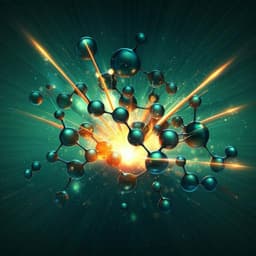
Chemistry
Turning copper into an efficient and stable CO evolution catalyst beyond noble metals
J. Xue, X. Dong, et al.
Experience the groundbreaking study by Jing Xue and colleagues, demonstrating a trimetallic single-atom alloy catalyst that achieves 100% CO selectivity for converting CO2 to CO with impressive stability and efficiency. This innovative research challenges traditional reliance on noble metals, paving the way for sustainable energy solutions.
~3 min • Beginner • English
Introduction
Electrochemical reduction of CO2 (CO2RR) to value-added products can help close the carbon cycle using renewable electricity. CO is an especially attractive product due to high economic value per electron and its utility as a building block for fuels and chemicals. Yet simultaneously achieving high CO selectivity, high current density, low overpotential, and long durability is challenging because CO2RR competes with the hydrogen evolution reaction (HER) and involves complex pathways. Noble metals (Au, Ag) exhibit low onset potentials and high CO selectivity but are costly, scarce, and tend to suffer from HER dominance at high production rates, limiting industrial viability.
Copper is unique in activating CO2 and producing a spectrum of products, but pristine Cu shows poor selectivity for monocarbon products (CO, formate). Prior Cu-based single-atom alloys (SAAs) can tune Cu’s electronic structure to favor specific products by balancing adsorption/desorption of intermediates; however, at high rates (>−500 mA cm−2) binary SAAs can reconstruct due to low dopant content, creating an activity–stability dilemma.
This study hypothesizes that co-alloying Cu with two distinct single-atom dopants increases the number of tuning parameters to enhance CO selectivity and activity while boosting stability via higher mixing entropy (lowering ΔG and suppressing aggregation). The authors design a trimetallic SAA, Cu92Sb5Pd3, in which isolated Sb and Pd single atoms synergistically modulate Cu’s electronic structure to promote CO evolution and suppress HER while improving structural stability under high-rate CO2 electrolysis.
Literature Review
The work builds on prior demonstrations that Au and Ag catalysts achieve high CO selectivity at low overpotentials but face cost, scarcity, and HER at high rates. Pristine Cu enables diverse CO2RR products with limited selectivity to CO. Binary Cu SAAs (e.g., with single-atom dopants) can tune Cu’s d-band to weaken CO binding, promote CO2 activation, and suppress C–C coupling, but suffer instability and reconstruction under high current densities. The authors reference prior reports of Sb-alloyed Cu enabling selective CO production and of potential-induced nanoclustering of Cu under CO2RR, motivating strategies to stabilize active sites. They invoke thermodynamic arguments that increasing element number raises mixing entropy (ΔSmix), reducing ΔG and improving stability, suggesting a trimetallic SAA as a route to reconcile activity, selectivity, and durability.
Methodology
Synthesis: Cu92Sb5Pd3 nanoparticles (10–20 nm) were synthesized by co-reduction in ethanol using NaBH4, avoiding complexants. Solution A: Pd(NO3)2·2H2O (14 mg), SbCl3 (28 mg), CuCl2 (294 mg) dissolved in EtOH, sonicated 15 min. Solution B: NaBH4 (0.95 g) in 11 mL EtOH/H2O (8:3) at 4 °C. Solution A was rapidly added to B at 4 °C under Ar, stirred 1 h. Product was washed (DI water, IPA), vacuum-dried, and stored in Ar. Control catalysts: Cu97Pd3, Cu95Sb5, and pure Cu synthesized analogously with adjusted precursors.
Characterization: ICP-AES for composition (Sb ~5 at%, Pd ~3 at%). XPS confirmed incorporation of Sb, Pd. XRD indicated pure Cu crystal structure without Sb/Pd nanoparticles or oxides. TEM/HAADF-STEM with EDS mapping showed atomic dispersion of Sb/Pd without aggregation. EXAFS (Sb, Pd K-edges; Cu K-edge) showed Sb–Cu and Pd–Cu coordination without Sb–Sb, Pd–Pd, or metal–O bonds, confirming single-atom dispersion in a metallic Cu matrix. Operando Cu K-edge XAS monitored electronic state under bias.
Electrochemistry: CO2RR tested in a three-electrode flow cell at room temperature with 0.5 M KHCO3 (pH 7.4; ~7.2 CO2-saturated) as catholyte and 1 M KOH as anolyte. Cathode prepared by spray-coating ink (12 mg catalyst + 24 μL 5% Nafion 117 in 2 mL IPA) on a gas diffusion layer (YLS-30T), ~1 mg cm−2 loading; geometric area 0.6 cm2. Ag/AgCl reference, Ni foam counter, Nafion 115 separator, CO2 flow 30 sccm, electrolyte flow 1.1 mL min−1. Potentials converted to RHE: ERHE = EAg/AgCl + 0.197 + 0.0592×pH − 0.85×iR; 85% iR compensation. At least three replicates per condition.
Product analysis: Gas products quantified online by GC (FID, TCD, Molsieve 5 Å). Liquid products quantified by 1H NMR (D2O, DMSO internal standard) and ion chromatography.
ECSA and H2 desorption: Gas-tight H-cell with 0.5 M KHCO3, Nafion 115 separator; Ar-purged catholyte. ECSA from double-layer capacitance; H2 desorption assessed by CV peaks in double-layer region.
Kinetics: Tafel analysis using η = k·lg(jCO) + b with E° = −0.11 V vs RHE for CO2 + H2O + 2e− → CO + 2OH−.
In situ/operando: DEMS in flow cell to track m/z 28 (CO) and 26 (C2H4) during LSV (5 mV s−1) for onset potential determination; in situ Raman (785 nm) and ATR-SEIRAS for adsorbed CO*; CO-DRIFTS to probe CO adsorption/desorption rates by saturating with CO then Ar purge. SVBS measured Cu d-band centers.
Durability: Long-term test in an MEA (zero-gap): 4 cm2 cathode, IrO2/Ti anode, Sustainion X37-50 AEM, CO2 at 40 sccm, 0.1 M KHCO3 anolyte refreshed every 4 days, operated at −100 mA cm−2 for 22 days without iR correction.
Computation: DFT (VASP) with rPBE functional, PAW, 400 eV cutoff, Cu(211) slabs (4 layers, bottom two fixed), k-mesh 4×2×1, solvation via VASPsol. Adsorption energies referenced to gas-phase molecules; reaction free energies ΔG = ΔE + ΔZPE − TΔS (300 K). Transition states via CI-NEB. Potential-dependent electrochemical barriers via charge-extrapolation within a capacitor model; microkinetic modeling with CATKINAS to compute rates, coverages, and FE. Surface energies computed to assess stability.
Key Findings
- Composition and structure: Cu92Sb5Pd3 forms a trimetallic single-atom alloy (SAA) with isolated Sb–Cu and Pd–Cu coordination and no Sb–Sb or Pd–Pd, verified by EXAFS/WT. No oxides detected. HAADF-STEM/EDS show atomic dispersion without aggregation.
- Electronic structure: Operando Cu K-edge XAS reveals partially electron-deficient Cu during reaction, indicating charge redistribution from Sb/Pd to Cu. SVBS shows Cu d-band center shifts from 2.73 eV (Cu) to 2.80 eV (Cu97Pd3), 2.83 eV (Cu95Sb5), and 2.87 eV (Cu92Sb5Pd3), consistent with weaker CO* binding. Bader analysis: Cu becomes electron-deficient; Sb/Pd electron-rich.
- CO2RR performance (0.5 M KHCO3, flow cell): FECO >95% maintained from −0.78 (±0.02) to −1.09 (±0.03) V vs RHE with HER <3%. Maximum FECO 100% (±1.5%) at jCO = −402 mA cm−2 around −0.93 (±0.03) V vs RHE. At ~−1.19 (±0.04) V, jCO > −700 mA cm−2 with FECO 90% (±2.8%). At −1000 mA cm−2, FECO 85% (±3.8%). Activity up to −1 A cm−2 in neutral electrolyte.
- Benchmarking: Outperforms or matches state-of-the-art Au/Ag catalysts in neutral media, which show rapid FECO decline at high rates due to HER. Cu92Sb5Pd3 maintains high selectivity at high current density.
- Kinetics: Tafel slope 138.7 mV dec−1 on Cu92Sb5Pd3 vs 237.6 (Cu), 211.2 (Cu97Pd3), 199.8 (Cu95Sb5), indicating faster kinetics; suggests first electron transfer to CO2 as RDS. DEMS shows lower onset potential for CO and higher for C2H4, evidencing suppressed CO*–CO coupling.
- Intermediates and adsorption: In situ Raman/ATR-SEIRAS show lower CO* coverage and easier CO* desorption on Cu92Sb5Pd3 than controls. CO-DRIFTS indicates fastest CO desorption on Cu92Sb5Pd3 (desorption rate order: Cu92Sb5Pd3 > Cu95Sb5 > Cu97Pd3 > Cu), correlating with near-unity CO selectivity.
- HER suppression: CV shows absence of hydrogen desorption peaks for Cu92Sb5Pd3 vs prominent peaks on Cu, confirming HER suppression by Sb/Pd co-doping.
- Stability: In MEA at −100 mA cm−2, FECO >95% for 22 days (528 h) without voltage drop. Post-mortem HAADF-STEM/EDS show Sb/Pd remain well-dispersed. Surface energies (eV/atom): Cu 0.22, Cu97Pd3 0.21, Cu95Sb5 0.19, Cu92Sb5Pd3 0.18, supporting enhanced stability via increased mixing entropy. Bimetallic Cu95Sb5 reconstructs/segregates under high current (−800 mA cm−2), unlike the trimetallic.
- DFT and microkinetics: On Cu(211), models with Sb and Pd dopants (Cu92Sb5Pd3-(211)-2) exhibit weaker CO* adsorption at top Cu sites adjacent to Sb/Pd vs Cu or bimetallics, lower barriers for CO2 activation/COOH formation at −0.93 V, and highest theoretical CO production rates. Steady-state CO* coverages: Cu92Sb5Pd3-(211)-2 (1.5%) < Cu92Sb5Pd3-(211)-1 (3%) < Cu95Sb5 (7%) < Cu97Pd3 (51%) < Cu (70%), consistent with spectroscopy and selectivity trends.
Discussion
The study addresses the central challenge of achieving high-rate, selective, and durable CO2-to-CO electrolysis without relying on costly noble metals. By co-alloying Cu with isolated Sb and Pd atoms, the catalyst’s electronic structure is tuned to weaken CO* binding and reduce surface CO* coverage, thereby limiting C–C coupling and favoring rapid CO desorption. Operando XAS and Bader analysis corroborate charge redistribution (electron-rich Sb/Pd and electron-deficient Cu), while SVBS shows a systematic d-band center downshift that rationalizes weaker adsorption of CO intermediates. This electronic tuning translates into faster kinetics (lower Tafel slope), lower CO onset potential, suppression of HER, and maintenance of high FECO at industrially relevant current densities.
The trimetallic SAA also solves the activity–stability dilemma: increased mixing entropy from adding two dopants stabilizes single-atom dispersion and reduces surface energy, preventing dopant aggregation under high-rate operation. Long-term MEA testing confirms durability with sustained FECO >95% over 528 h. Compared with noble metals (Au, Ag) in neutral electrolytes, which suffer from HER at high rates, Cu92Sb5Pd3 achieves comparable or superior selectivity with much higher sustained current densities.
Overall, the synergistic Sb/Pd co-doping on Cu provides a coherent mechanistic framework linking electronic structure modification, adsorption energetics, kinetics, and macroscopic performance, demonstrating a viable non-noble path to scalable CO production.
Conclusion
The authors present a trimetallic single-atom alloy catalyst, Cu92Sb5Pd3, that delivers near-unity CO selectivity and very high current densities in neutral electrolyte while maintaining exceptional durability. Synergistic Sb and Pd single atoms modulate the Cu d-band to weaken CO* binding, suppress C–C coupling and HER, and accelerate CO formation kinetics. Increased mixing entropy enhances structural stability, preserving single-atom dispersion during prolonged operation. Experimentally, FECO reaches 100% (±1.5%) at jCO = −402 mA cm−2 and remains >95% over a broad potential range and for 528 h at −100 mA cm−2 in an MEA. DFT and microkinetic modeling identify active structures with lower barriers and low CO* coverages consistent with in situ spectroscopy.
This work establishes a design principle for multi-element single-atom alloys to surpass noble metals for CO2-to-CO conversion. Future research can explore other dopant combinations, extend to different supports and electrolytes (including acidic or alkaline regimes), scale to larger-area devices at higher current densities for long-term operation, and integrate with downstream processes for syngas or chemical synthesis.
Limitations
- Operando detection of Sb and Pd K-edges was not achieved due to low dopant contents, so electronic insights for dopants are inferred indirectly (via Cu K-edge and Bader analysis) rather than measured directly under reaction conditions.
- HAADF-STEM cannot differentiate Sb vs Pd single atoms because of similar atomic numbers, limiting direct assignment of individual dopant identities in imaging.
- Long-term durability was demonstrated at −100 mA cm−2; stability at higher current densities (e.g., ≥−400 to −1000 mA cm−2) over similarly long durations was not reported.
- Performance and stability were demonstrated primarily in neutral electrolytes; broader validation across electrolyte conditions and device configurations remains to be explored.
Related Publications
Explore these studies to deepen your understanding of the subject.







